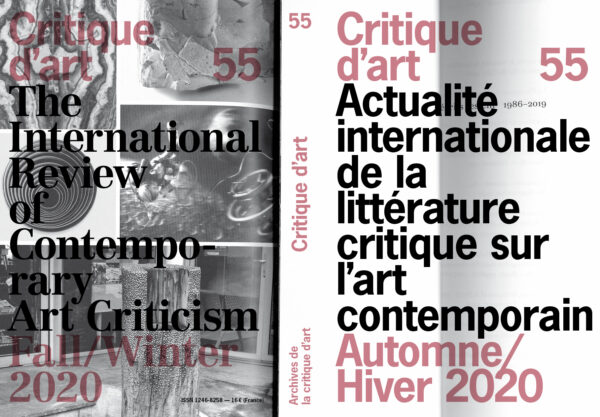N° 55

Editorial
« The Global Now » : apothéose et déclin“The Global Now”: Apotheosis and Decline
Maria Stavrinaki
Serions-nous en train de nous dégager déjà de l’étreinte du « global » ? A l’âge de l’Anthropocène, où les humains se donnent en temps réel le triple rôle d’agents, de témoins et d’historiens des interactions du climat, du vivant et de la géologie, la catégorie épistémologique trop humaine du « global » connaît à la fois son apothéose et le début de son déclin au profit du « planétaire ». Certes, les deux catégories sont loin d’être incompatibles, et ce qu’Anna Tsing a appelé avec malice « le charisme du global » exerce son efficace plus que jamais dans les sciences humaines, ainsi qu’en témoigne la reconnaissance dont jouit cette notion dans les institutions occidentales et quelques publications passionnantes chroniquées dans ce numéro de Critique d’art. Mais ce « charisme » est infléchi, voire fissuré par des nouveaux questionnements qui travaillent actuellement savoirs, discours et pratiques artistiques et, bien sûr, la parole politique. Gayatri Chakravorty Spivak, figure pionnière de la pensée féministe postcoloniale, fait ainsi la part entre le « globe », qui se situe « dans nos ordinateurs » et ne peut, en tant que tel, être « vécu », et la « planète », altérité radicale vivante et habitable, mais seulement à crédit, susceptible d’englober « une taxinomie inépuisable de noms d’altérités humaines »[3]. « Le global révèle aux humains le domaine du planétaire », dialectise à son tour Dipesh Chakrabarty […]
/
Are we in the process of already freeing ourselves from the grip of the “global”? In the Anthropocene age, when human beings are casting themselves, in real time, in the triple role of agents, witnesses and historians of the interactions of climate, living world and geology, the epistemological “too human” category of the “global” is experiencing both its apotheosis and the beginning of its decline, in favour of the “planetary”. To be sure, the two categories are far from being incompatible, and what Anna Tsing has mischievously called “the charisma of the global” is brandishing its effectiveness more than ever in the human sciences, as is illustrated by the recognition this notion is enjoying in western institutions and in one or two extremely interesting publications reported in this issue of Critique d’art. But this “charisma” is qualified, not to say flawed, by new questions which are currently exercising knowledge, discourse and art praxis and, needless to add, the political word. Gayatri Chakravorty Spivak, a pioneering figure of post-colonial feminist thinking, makes a distinction between the “globe”, which is situated “in our computers” and cannot, as such, be “experienced”, and the “planet”, a living and inhabitable radical otherness, but only on credit, capable of encompassing “an inexhaustible taxonomy of names of forms of human otherness”. “The global reveals to humans the sphere of the planetary”, explains, in his turn, Dipesh Chakrabarty […]
Texte intégral en pdfSommaire
Articles
A Rhythmic-Cosmic Language: Folk Art as a Global Resource
Marina Dmitrieva
Voir la revue en ligne
Habeas Corpus: a Body of Art from the Incarcerated America
Anna Iatsenko
Voir la revue en ligne
Radio art, between autonomy and hybridation
David Christoffel
Voir la revue en ligne
Drawing and Scientific Environments, from Ruskin to Rover
Anne-Lyse Renon
Voir la revue en ligne
Traduction
Traduction extraite de : "¡Presente! The Politics of Presence", Durham : Duke University Press, 2020, p. 226-244
Diana Taylor
Introduit par / Introduced by : David Zerbib
Voir la revue en ligne
Essai
The Countryside, the Future: Art and Rurality in Times of Crisis
Camille Azaïs
Introduit par Elitza Dulguerova, Adeline Blanchard
Voir la revue en ligne
L'Histoire revisitée
Across the past and present of engaging with colonial contexts in the arts and in cultural institutions
Felicity Bodenstein
Voir la revue en ligne
The Exhibition. Theories and Practices
François Aubart
Voir la revue en ligne
In Real Life – A Reflection on the ‘Online Exhibition’
Adeena Mey & David Morris
Voir la revue en ligne
Archives
Germano Celant : Archive as Practice
Lara Conte
Voir la page
Complétez votre lecture
269 ouvrages francophones et internationaux repérés dans l’actualité éditoriale d’avril à septembre 2020. Livres, catalogues et créations de revues ont été confiés à des auteurs chargés d’évaluer la littérature sur l’art contemporain produite ces six derniers mois.
Toute la fabrique des notes de lecture en ligne sur journals.openedition.org/critiquedart
Les auteurs développent librement des opinions sur les livres et les catalogues, qui n’engagent qu’eux-mêmes.
/
269 French-speaking and international publications spotted on the publishing scene from April to September 2020. Books, catalogues, and newly created reviews: a group of authors was commissioned to evaluate what has been written on contemporary art over the past six months.
